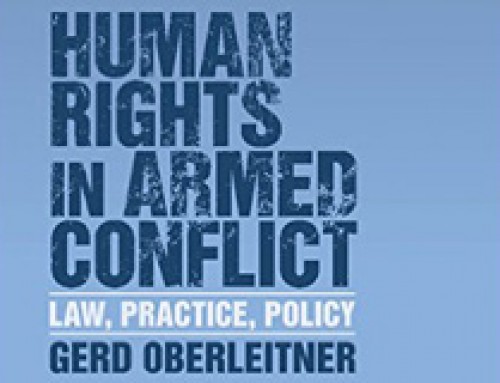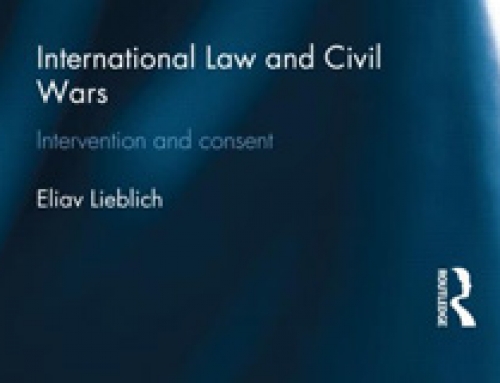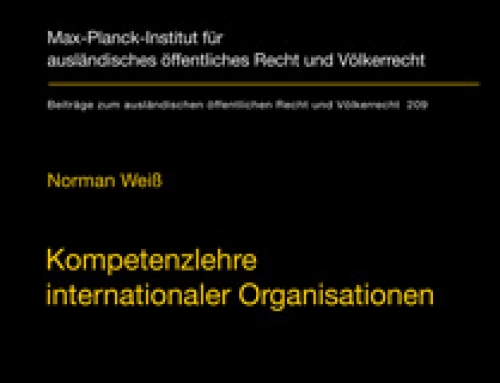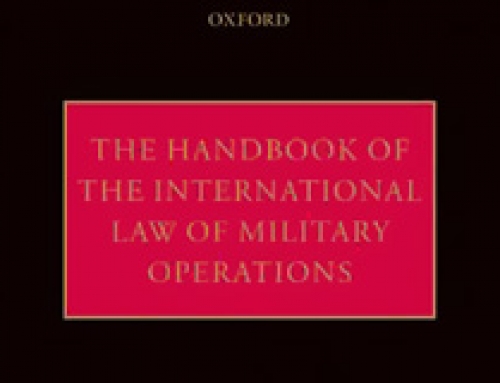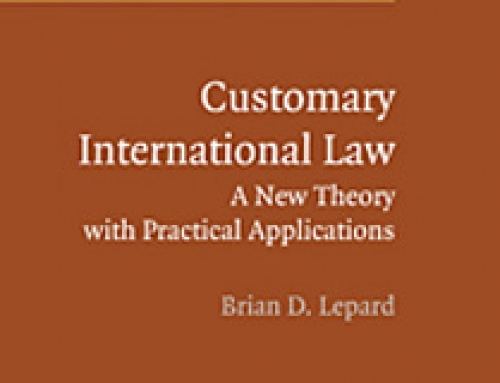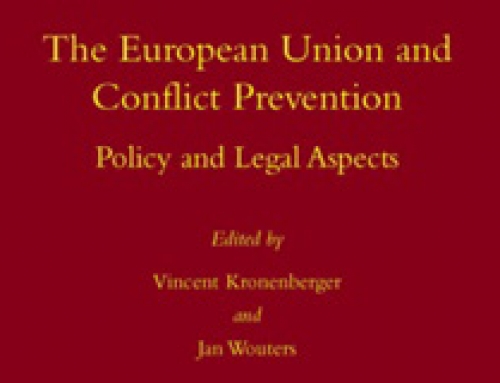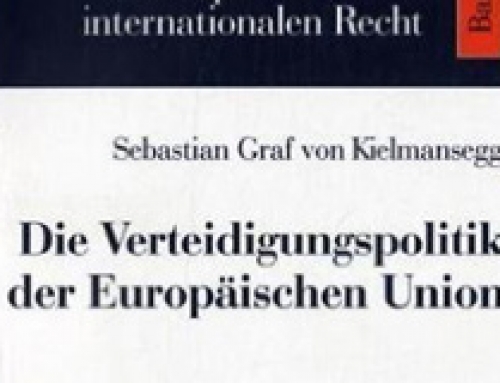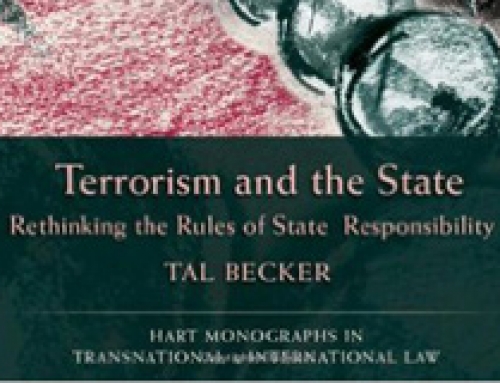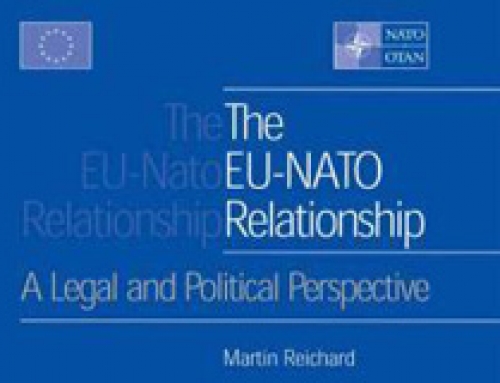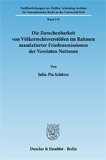
Die Zurechenbarkeit von Völkerrechtsverstößen im Rahmen mandatierter Friedensmissionen der Vereinten Nationen. [The Attribution of Internationally Wrongful Acts in the Context of UN-mandated Peace Operations] Julia-Pia Schütze. Berlin: Duncker & Humblot. 2011. 247pp. €82. ISBN 978-3-428-13460-1.
Over the course of the past two decades, peace operations have emerged as a standard tool of international conflict resolution, routinely employed in a broad range of conflict scenarios and tasked with a seemingly ever-increasing range of responsibilities. Despite their widespread use, peace operations nevertheless remain a somewhat blunt instrument of international diplomacy. While the deployment of armed forces is often necessary to re-establish peace and security in societies plagued by conflict, experience shows that the conduct of military missions in difficult operational circumstances creates ample opportunities for the infringement of some of the very values and norms they are charged to promote and protect. In recent years, attention has therefore increasingly focused on the need to regulate the conduct of peace operations in greater detail and to subject them to more robust accountability mechanisms. However, these efforts continue to be hampered by institutional and legal complexities. In particular, the fact that peace operations involve contributions from several States and usually entail the participation of one or more international organization means that it may not be immediately obvious to which party their wrongful conduct should be imputed. Over the past few years, the rules governing the attribution of the acts of peace operations have been the subject of intense discussion in the academic literature, fuelled in part by the widely criticized admissibility decision of the European Court of Human Rights in the Behrami and Saramati cases1 and by the conclusion of the International Law Commission’s work on the responsibility of international organizations.2
The present book forms part of this line of the literature. Its main objective is to clarify whether the European Court’s decision in Behrami to impute the wrongful acts of Kosovo Force (KFOR)—a peace operation mandated by the UN, but conducted by NATO—to the UN is compatible with the rules of international law governing the attribution of conduct under such circumstances. This topic is of considerable interest. Since the end of the Cold War, the Security Council has repeatedly relied on its Chapter VII powers to authorize Member States of the UN to conduct peace operations with the assistance of regional or other international organizations, for instance in the case of the International Security Assistance Force (ISAF) in Afghanistan. Compared to peacekeeping operations established and led by the UN itself, the involvement of other international organizations in the conduct of operations authorized by the Security Council adds a further layer of difficulty to the accountability problem sketched above: not only does it increase the complexity of the applicable institutional and legal arrangements and thereby render attribution more difficult, but it also raises the question whether responsibility should be shared in some way between the different international actors involved.
The book opens with a discussion of the place of peacekeeping within the UN collective security system and proceeds to recount the basic features of the law of international responsibility as it applies to States and international organizations. Although competently written, the fact that these two preparatory chapters make up a rather large part of the book betrays its origins as a doctoral dissertation. The third chapter continues in a similar vein and offers a review of international practice concerning the attribution of wrongful conduct in peace operations. The picture that emerges from this review is clear as far as UN-led operations are concerned: as Schütze rightly concludes, international practice suggests that a presumption exists in favour of attributing the wrongful acts of UN peacekeeping operations to the UN either on the basis that it is presumed to exercise effective control over them or because they constitute one of its subsidiary organs. Conversely, since the UN does not exercise effective control over operations led by other international actors nor does it formally incorporate them into its institutional structure, neither of these two grounds of attribution are applicable to missions authorized, but not conducted by the UN. It follows that wrongful acts committed in the course of such operations in principle must be attributed either to the participating States or to the international organization leading them, but not to the UN. However, the European Court’s decision in Behrami marks a departure from this broad consensus, for the looser test of ‘ultimate authority and control’ favoured by the Court also seems to permit the attribution to the UN of wrongful acts committed by members of peace operations that are merely authorized, but not led by it.
In what forms the central part of her work, Schütze turns to assess the relative merits of these two different standards of attribution. Considering the findings of the preceding chapter and the overwhelmingly negative reception of Behrami in the literature, it is perhaps not a great surprise to find that the author rejects the ultimate authority and control test put forward by European Court as flawed. Those who have followed the Behrami saga closely over the past few years will find that most of the arguments employed by Schütze have a familiar ring; there is no need to rehearse them here. However, as a side-note, it is interesting to observe that Schütze also rejects as unconvincing the attempt by the majority of the House of Lords to distinguish the legal position of KFOR from that of the Multinational Force (MNF) in Iraq in the case of Al-Jedda.3 For Schütze, the relevant Security Council resolutions authorizing these two operations are identical in their legal effects: if the ultimate authority and control test has led to the attribution of KFOR’s conduct to the UN in Behrami, then applying the same test to the MNF must lead to the attribution of its conduct to the UN too. Of course, the European Court has sought to avoid precisely this outcome in its own decision in Al-Jedda by following in the footsteps of the majority of the House of Lords and distinguishing the legal position of KFOR from that of the MNF.4 However, repetition does not make that distinction any more persuasive.5 Moreover, while in Al-Jedda the European Court rightly held that the applicant’s detention at the hands of British forces could not be attributed to the UN, the fact that it has based this conclusion on the notion that ‘the United Nations Security Council had neither effective control nor ultimate authority and control over the acts and omissions of troops within the Multi National Force’ suggests that the Court may be having second thoughts about the suitability of the ultimate authority and control test laid down in Behrami.6
In chapter 5, the author studies three selected peace operations—KFOR, the EU-led naval operation EUNAVFOR Atalanta and ISAF—in an attempt to determine where effective control lies in the case of missions authorized by the UN. This is perhaps the most interesting chapter of the book, for based on a review of the command and control arrangements applicable in such operations, Schütze argues that effective control over national contingents remains with the troop-contributing nations and does not normally pass to the international organization conducting the operation. If this is indeed the case, it follows that the UN does not exercise effective control over its own peacekeeping missions either, given that the applicable command and control arrangements do not differ significantly from those employed in NATO-led operations. In essence, Schütze suggests that no international organization ever seems to exercise effective control over peace operations save in exceptional circumstances and that consequently the acts of national contingents serving in international military operations must normally be attributed to their respective contributing States. However, this conclusion contradicts Schütze’s earlier finding that a presumption has arisen in international practice in favour of attributing the wrongful acts of UN peacekeeping operations to the UN. Schütze attempts to resolve this contradiction with reference to the nature of the powers exercised: whereas States participating in UN-led peacekeeping operations act in an international capacity because they exercise the original competences of the UN itself, States participating in peace operations led by other international organizations, such as NATO, do not exercise the competences of those other organizations, but the powers of the UN (at 194–195 and 225–226). This argument raises two problems. First, it seems to reintroduce Behrami through the back door, considering that the UN is said to incur responsibility for the acts of its peacekeeping operations on the basis that the latter exercise competences delegated to them by the Security Council. Second, if States and international organizations participating in UN-authorized operations are said to exercise delegated competences of the UN, this might explain why the acts of national contingents should not be attributed to the participating international organizations, but it does not explain why they should not be attributed to the UN in the same way as in the case of UN-led operations. Regrettably, Schütze fails to acknowledge and address these problems. A more convincing way to distinguish between UN-led and UN-authorized operations is to focus on their different institutional status: whereas the former are subsidiary organs of the UN, the latter are not. Arguably, and contrary to what the Draft Articles on the Responsibility of International Organizations suggest, the status of UN-led operations as subsidiary organs is a sufficient ground for attributing their conduct to the UN.7
Overall, this is a well-written book which addresses a topic of considerable interest, but adds relatively little to the existing academic literature. The weaknesses of the ultimate authority and control test proposed by the European Court of Human Rights in Behrami have already been discussed extensively and there is not much that the present book can usefully add here. While Schütze’s attempt to develop a more precise understanding of the content of the effective control test deserves attention (at 169ff.), her efforts are somewhat eclipsed by more recent and more detailed contributions on this topic.8 Nonetheless, the book provides some food for thought, in particular the author’s powerful argument that international organization typically do not exercise effective control over national contingents participating in peace operations.
Published in the Journal of Conflict and Security Law.
1 Behrami and Behrami v. France and Saramati v. France, Germany and Norway, App. No. (2007) 45 EHRR SE10.
2 Draft Articles on the Responsibility of International Organizations, with Commentaries, in Report of the International Law Commission, Sixty-third session, UN doc. A/66/10 (2011), 52.
3 R. (Al-Jedda) v. Secretary of State for Defence [2007] UKHL 58 (House of Lords), esp. at paras 22–24.
4 Al-Jedda v. United Kingdom (Application no. 27021/08), Judgment of 7 July 2011 (Grand Chamber), para. 83.
5 See A. Sari, ‘The Al-Jedda Case before the House of Lords’, (2009) 13 Journal of International Peacekeeping 181, at 193–195.
6 Emphasis added. See also F. Messineo, ‘Things Could only Get Better: Al-Jedda beyond Behrami’, forthcoming in (2012) 50 Military Law and the Law of War Review.
7 For a more detailed version of this argument, see A. Sari and R. A. Wessel, ‘International Responsibility for EU Military Operations: Finding the EU’s Place in the Global Accountability Regime’, in B. van Vooren, S. Blockmans and J. Wouters (Eds.), The Legal Dimension of Global Governance: What Role for the EU? (Oxford University Press, 2013).
8 See T. Dannenbaum, ‘Translating the Standard of Effective Control into a System of Effective Accountability: How Liability Should Be Apportioned for Violations of Human Rights by Member State Troop Contingents Serving as United Nations Peacekeepers’, (2010) Harvard International Law Journal 113.

